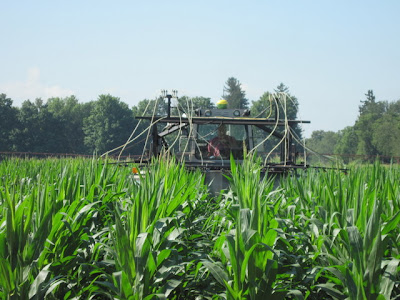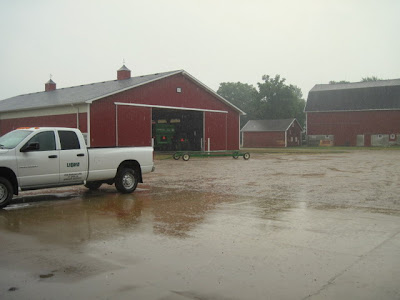Shhhh....I want to tell you something...OK, maybe not that, but the NCRS did have another visitor today. It's kind of a secret. It seems that Agro-Culture Liquid Fertilizers is filming another commercial, and had a film production crew here today. It was LeCrone Communications from Hilliard, Ohio, and we had Brian LeCrone himself. Now I can't tell you exactly what the commercial is about...mainly because I don't know myself. But I gathered that it had something to do with corn. In the picture below, we cut out some corn to enable filming with their cool boom camera. (Marketing will have to re-imburse us for the estimated 0.6 bushels of corn lost for this.) We see Phil providing quality control, while Stephanie stays within earshot in case of mistakes or questions. So how was I able to get this spectacular overhead shot? Well I was in a basket on a fork lift. I took lot's of pictures while up there, including some that were work-related, such as this view of our crops here on Farm 5. Looking good if you ask me.
So how was I able to get this spectacular overhead shot? Well I was in a basket on a fork lift. I took lot's of pictures while up there, including some that were work-related, such as this view of our crops here on Farm 5. Looking good if you ask me.
 So how was I able to get this spectacular overhead shot? Well I was in a basket on a fork lift. I took lot's of pictures while up there, including some that were work-related, such as this view of our crops here on Farm 5. Looking good if you ask me.
So how was I able to get this spectacular overhead shot? Well I was in a basket on a fork lift. I took lot's of pictures while up there, including some that were work-related, such as this view of our crops here on Farm 5. Looking good if you ask me.




 The hives have an opening on the bottom for the bees to go in and out. However, one hive had no activity, as seen in the picture below. We learned from the beekeeper that it had lost it's queen. So no queen, no hive.
The hives have an opening on the bottom for the bees to go in and out. However, one hive had no activity, as seen in the picture below. We learned from the beekeeper that it had lost it's queen. So no queen, no hive.





































 Before it rained, Stephanie and I did some more crop tissue testing for nutrients. This particular experiment is evaluating several different existing and experimental N fertilizers applied at a range of rates. So knowing differences in crop uptake may be useful, along with yield of course. Personally I am still at odds over the effectiveness of tissue testing due to often conflicting results that don't follow through to yield. But testing often does eliminate wondering. As stated in an earlier blog on tissue testing, correct sampling and staging procedures will influence results. So here is Stephanie standing next to a corn plant with lots of leaves, but not yet tasseling or silking. So we know it is still in the vegetative stage of growth. So what is the correct stage? You know that you need to count leaves with a collar, but where do you start???
Before it rained, Stephanie and I did some more crop tissue testing for nutrients. This particular experiment is evaluating several different existing and experimental N fertilizers applied at a range of rates. So knowing differences in crop uptake may be useful, along with yield of course. Personally I am still at odds over the effectiveness of tissue testing due to often conflicting results that don't follow through to yield. But testing often does eliminate wondering. As stated in an earlier blog on tissue testing, correct sampling and staging procedures will influence results. So here is Stephanie standing next to a corn plant with lots of leaves, but not yet tasseling or silking. So we know it is still in the vegetative stage of growth. So what is the correct stage? You know that you need to count leaves with a collar, but where do you start???



